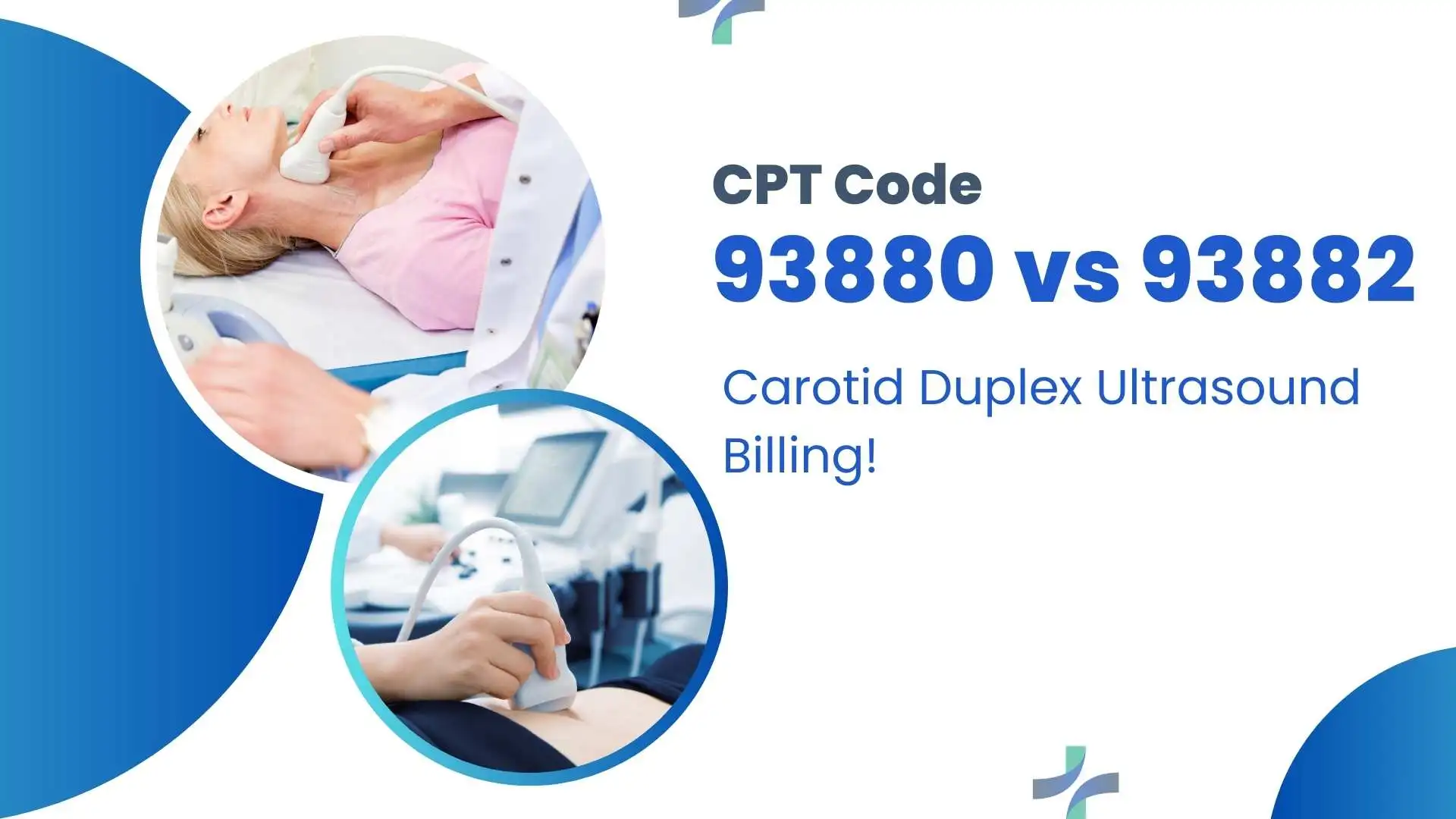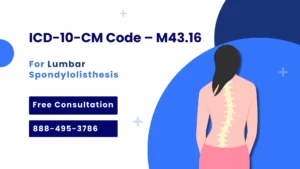Understanding medical billing intricacies, especially CPT codes, is the backbone of each practice’s revenue cycle. As a starting point, consider two of the codes under discussion: CPT code 93880 and CPT 93882, which both pertain to carotid ultrasounds. This blog seeks to explain their application and documentation as well as the billing aspects, irrespective of your experience level.
Understanding the basics of both CPT codes
CPT 93880 is the code reported for a complete bilateral study of extracranial arteries. This is an ultrasound of both carotid arteries, and the purpose is to assess blood flow, blockages, and abnormalities. This type of comprehensive scan is done employing ultrasound imaging and Doppler to give a detailed look at the arteries’ structure and function.
The second one is CPT 93882, which is a unilateral study code. This code specifies that ultrasound is done only on one side of the neck. It is done when some issues are known, and the ultrasound is just performed to check the conditions or for follow-up checkups.
When to use each code
The choices made under 93880 and 93882 are ingrained in the clinical scenario presented:
Use CPT code 93880 when
· There is an intention to evaluate both carotid arteries.
· The patient exhibits clinical features such as dizziness, TIA, and other findings indicating possible ischemic changes in both vascular regions.
Prerequisites, including routine assessments for high-risk patients or pre-surgical workups, undergo a multi-parametric analysis each time they are scheduled for the procedure.
Use CPT code 93882 when
- A unilateral study means that only one carotid artery requires examination
- The procedure is done to check the previously known issue on the side of the neck
- A limited evaluation is enough based on the patient’s symptoms and old medical history
Both unilateral and bilateral studies need to justify the rationale prompted ahead of advance in order for reimbursement to flow smoothly and to avoid denial and issues.
Documentation Essentials
To be considered holistic and integrative, billing needs to be triangulated with functional documentation. Accompanying the following elements alongside the 93880 CPT code and 93882:
Research Basis: Document clearly the basic reason why the Ultrasound is ordered. Its order needs to be noted.
Procedure:
· Mention the type of study, is it unilateral or bilateral
· Color spectra, Doppler, or spectral Doppler were employed to evaluate
· Impression and Analysis should conclude the analysis to form a complete body of work. Suggest treatments for further examination or issue along with evaluations marking each action taken with results derived.
· Claims offering no clarity at all to reasoning make themselves the perfect target to be stripped clear of funds while reduced compliments.
Insights on Billing and Reimbursement
It is critical to comprehend the nature of the reimbursement landscape for each:
For CPT 93880:
· Considered more reimbursable because of the comprehensive nature of the study.
· Confirm that both sides were indeed evaluated and documented to support the justification of this code.
For CPT code 93882:
· Reimbursed at lower rates corresponding to the limited scope of the study.
· Applicable when only one side is examined, or when performed as part of follow-up assessments.
Remember to check specific guidelines from payers, as reimbursement procedures and requirements may differ.
Avoiding Common Mistakes
Caution: Even the most experienced veterans of the field may find themselves tripping. Here are some very basic blunders, along with suggestions on how to avoid them:
· Over-coding: Billing CPT 93880 when only a unilateral study was performed. Be sure always to verify that the code billed corresponds to the procedure performed.
· Under coding: 93882 CPT code is used to describe bilateral work done in an attempt to fly under the radar. This invites scrutiny and risks lost revenue streams.
· Incomplete Documentation: Not capturing the use of Doppler techniques or the capture of peripheral arteries does not meet the minimum requirements. Capture all procedural details as much as possible.
· Ignoring Payer Policies: Not all insurers have the same criteria, and therefore, requirements will vary. Keep up to date on guidelines to stay compliant.
Real-World Application
Imagine a realistic hypothetical example:
A 66-year-old patient comes with symptoms like dizziness and also has a history of high blood pressure. In that case, doctors order a carotid ultrasound.
Now, these two codes have applications in the following ways:
· When both carotid arteries are looked at, and blood flow measurement using Doppler techniques is done, 93880 is appropriate.
· If only the right carotid artery is performed due to prior suspected narrowing, leaving the left side asymptomatic, then unilateral codes will apply, and CPT code 93882 will be the appropriate answer.
In both circumstances, having the appropriate justifying documentation explaining the limits and conclusions of the investigation is important.
Additional Related Codes
While 93880 and 93882 pertain to carotid duplex scans, other related ultrasound procedures include:
- CPT 76700: CPT code for ultrasound of the abdomen.
- CPT 76705: Limited abdominal ultrasound.
- CPT 76856: Non-obstetric Complete pelvic ultrasound.
- CPT 76857: Non-obstetric Pelvic ultrasound, limited or follow-up.
- CPT 93308: Echocardiography; follow-up or limited transthoracic echocardiography.
In order to promote compliance and maximize reimbursement, be sure that the codes chosen represent the exact procedure performed.
Staying Updated
As in any other healthcare discipline, the field of medical billing is ever evolving. Be sure to reference the American Medical Association as well as the Centers for Medicare and Medicaid Services for the most current billing instructions and CPT codes. Getting relevant work experience and engaging in lifelong learning will always keep you ahead of the competition.
Just as understanding carotid ultrasound codes like 93880 and 93882 is essential, it’s equally important to stay updated on other foundational CPT codes—such as CPT Code 97161 for low-complexity physical therapy evaluations—to ensure compliance and avoid claim denials across all specialties.
How Having the Right Medical Billing Partner Can Make a Difference
Every CPT code, including 93880 and 93882, comes with billing nuances that restrict providers—getting the documentation, correct ICD-10 codes that cover 93880 code matches, modifiers, and claim submission right. A proficient medical billing company works with the provider, guiding them through the maze and filing the claims correctly on the provider’s behalf. A proficient billing partner does not merely submit claims; they process claims with an intimate understanding of carotid duplex CPT code and ultrasound abdomen CPT code billing, paired with reimbursement processes
Final Insights
Understanding and effectively documenting intuitive CPT codes 93880 and 93882 isn’t as complicated as it seems. It requires aligning the code to the corresponding procedure performed, documenting justifications, and knowing the requirements set forth by the payers’ contracts. When following those steps, one is able to attain accurate billing, maximum reimbursement, and most importantly, optimized patient care.




